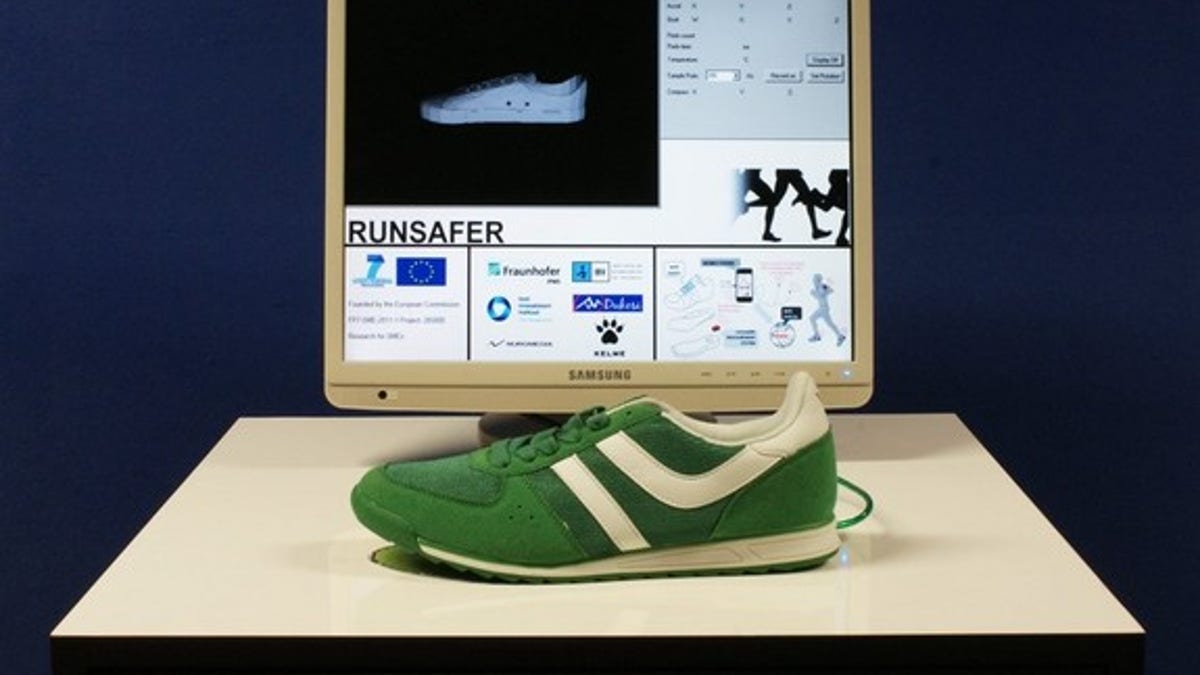
Wired model of a running shoe with built-in sensors. (Fraunhofer Institute)
Running shoes may soon be smart enough to tell their wearers how to improve their technique, which could prevent injuries.
A combination of sensor technology, wireless communications and smartphone apps is transforming the humble running shoe into a sophisticated monitoring device. By closely monitoring how and where the runner's foot hits the ground, and how often, innovators are finding ways to identify problems with a runner's gait.
One such running shoe effort is the RUNSAFER project, which is ongoing at the Fraunhofer Institute in Germany, in partnership with other universities and a shoe manufacturer. The researchers are building a running shoe that has sensors to transmit data to a smartphone and then to a computer.
The shoe's sensor logs data about the runner's foot speed as it hits the ground, as well as its orientation in space, the duration of contact with the ground and the runner's stride length. If the phone is out of Bluetooth range, the shoe will also store the data.
That data enables the software to calculate the forces acting on the foot. "It will tell you if the gait is correct," said Andreas Heinig, a scientist at Fraunhofer who manages the wireless microsystems group. "The running provides real-time feedback."
A gait that is slightly wrong can be a sign of injury, or plain old bad habits. But a bad gait can cause injuries, just as overtraining or falls can. The software can help the runner create a better running regimen. [10 Fitness Apps: Which Is Best for Your Personality?]
There are still experiments to be done to improve the technology before it becomes available to consumers. The shoes could be on store shelves within two years, Heinig told LiveScience.
The project is just one of several such efforts coming out of the shoe industry, said Jay Dicharry, a physical therapist and lab director at the REP Biomechanics Lab in Bend, Ore. Pressure plates have been inserted into running shoes before, but in recent years, the technology has grown more sophisticated, he said.
For example, Pegasus Sports Performance, a U.S. company, has developed a shoe sensor that measures eight aspects of the foot's motion as it hits the ground, including the dynamic of the kick. Pegasus' system also links to a smartphone and the Internet.
However, Dicharry said that although researchers have focused their innovations on gathering data on the way the foot hits the ground, there are problems with relying on that data. For instance, there's not necessarily one "right" way to run, because each person's body is a bit different.
"There are thousands of variations of foot strikes that are all OK," he said. "If you put a sensor on the shoe, it says how you strike, but not why." In his own lab, Dicharry measures the movement of the leg and the angle of the body, as well as the position of the center of gravity.
Max Prokopy, director of the SPEED Clinic at the University of Virginia, has studied the techniques of elite runners. He said he agreed that the data from the feet alone isn't always complete.
"You need more detail than foot insoles could give," Prokopy said. "You need a full biomechanical exam." Still, thenew wearable technology is good for getting feedback quickly, and allowing the runner to try different postures, styles or strides, he said.
Copyright 2013 LiveScience, a TechMediaNetwork company. All rights reserved. This material may not be published, broadcast, rewritten or redistributed.
